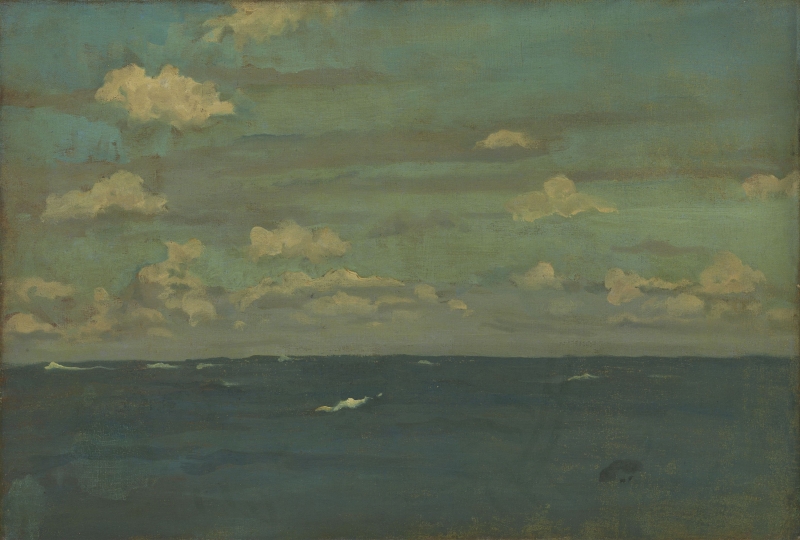Technique
Violet and Silver: A Deep Sea [YMSM 411] and Dark Blue and Silver [YMSM 412] are alike in scale and technique. The size of the canvas for Violet and Silver: A Deep Sea corresponds closely to the French 'toile de vingt' (50 x 73 cm) and it may have been acquired in France. Whistler had not painted seascapes this big for over twenty-five years, and was never to do so again. Kimberley Muir, who analysed the medium and technique, describes the canvas as having an open plain weave, the threads varying in density and thickness, prepared with a ground of deep-red over a grey layer. 1 The pigments used for the painting include lead white, iron oxide or earth pigments, umber, cobalt blue, ultramarine blue, and bone black, and Whistler's brushes varied from very narrow to broader brushes 10 mm wide. 2
The colours in Dark Blue and Silver are vivid – a deep cobalt blue sea, with a thick worm of white paint for a breaking wave, under a dark turquoise sky with soft puffy clouds of dove-grey touched with cream, painted wet-in-wet with a large brush. Whistler rubbed down some of the paint while it was still wet, revealing the reddish ground, and in some case rubbing right down to the canvas. The canvas was painted broadly, but not completed in one session, for there are signs of alterations on the left, where there was originally a large white wave. It was probably touched up in the studio once Whistler returned from working either en plein air or en plein mer!
Conservation History
On 9 January 1894 Whistler wrote to his restorer, Stephen Richards (1844-1900):
'Two paintings of mine - sea pieces - I am sending to the Grafton Gallery. -
Indeed they went yesterday -
I have written to Mr Prange to say that I want you to have them on their arrival - And now I will tell you what I want you to do -
The pictures are quite new, having been painted only this autumn - I have put a thin coat of varnish on them about a month or six weeks ago - I don't think any harm can come to them because of it - for they are so simply and directly painted, One painting only - no second coat of any kind or retouching - so that there really is nothing to crack!
Now I just want you to take them out of their frames - and give them a beautiful coat of varnish - not too thick - but you know what pleases me - so that the surface shall be perfect -
… Clean well the glass, and frame perfectly the pictures again - after they have dried sufficiently - and paste the stre[t]cher into the frame at the back ...
You will notice that one of the pictures has been slightly torn - up in the right hand corner - by the scoundrel who stretched it - and there is the mark of a nail that the brute drove at the time into the stretcher -
However I don't think I would touch this at present. Wait till it comes out of the exhibition and we will see - You will find that the frame just covers the tiny hole of the nail.' 3
The conservation and condition of the painting are discussed by Kimberley Muir in the Art Institute of Chicago online catalogue, who states:
'The painting currently has an overall natural-resin varnish (estimated) layer (probably more than one layer), which is somewhat glossy, uneven, and yellowed. … Overall, the painting is in good condition. The lined canvas is stretched taut and in plane. The original canvas seems weak, due to the quality and open weave of the canvas.' 4
Frame
A Grau Whistler frame, possibly made for exhibition in 1894. 5
Notes:
1: Muir notes that 'the gray layer contains lead white, barium sulfate, bone black, and a blue pigment. The red layer contains a mixture of lead white and iron oxide or earth pigments, with some bone black and chalk … unevenly applied.' Muir, Kimberley, 'Cat. 34 Violet and Silver—The Deep Sea, 1893: Technical Summary,' in Whistler Paintings and Drawings at the Art Institute of Chicago, The Art Institute of Chicago, 2020, URL.
2: Muir 2020, ibid.
3: [9 January 1894], GUW #10719.
4: Muir 2020, op. cit.
5: Dr S. L. Parkerson Day, Report on frames, 2017; see also Parkerson 2007 [more] .
Last updated: 7th June 2021 by Margaret







